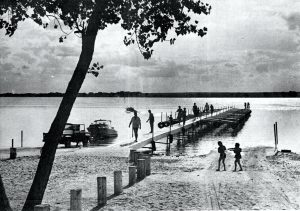An unexpected effect of Covid-19 has been a surge nationwide in recreational vehicle and camper sales. Many families are purchasing RVs in order to have family vacations that avoid crowds, cities and exposure to the coronavirus. Many state lakes and privately owned RV parks have been filled to capacity every weekend this summer. There’s no doubt that some of those campers would make Kearny County their destination if Lake McKinney was still open to the public. For around 70 years, the lake attracted campers, scouting groups, fishermen, hunters and other adventure seekers.
The United States Sugar and Land Company constructed Lake McKinney, also sometimes known simply as the reservoir or Reservoir #5, between Lakin and Deerfield in February 1907. Named for J. R. McKinney who was treasurer of the US Sugar and Land Company and an early pioneer of the sugar beet industry in southwest Kansas, the lake was the largest man-made one in the state at that time covering roughly 3,000 acres of land and holding over 30,000 acre feet of water. Lake McKinney was fed by the waters of the Arkansas River through the Great Eastern Canal, and then by the Amazon Canal when the Great Eastern was abandoned. Water was held at the reservoir and released when needed for irrigation.
In Volume II of the History of Kearny County, Irene Frazer Boughton reminisced about her first glimpse of Lake McKinney as a five-year-old, “The lake must have been in the filling stages, for I saw great cottonwoods turning yellow as they stood in the water clear up to their branches—some were almost submerged.” The image of a large two-story white home standing in the lake with water almost to its second story remained vivid in her mind many moons later. The reservoir covered ground that was formerly occupied by farms. Many farmers gave up their homes and farms, but some did not sell willingly and their land was taken from them. This led to lawsuits against the Sugar and Land Co., which after numerous foreclosures and name changes, became known as the Garden City Company.
By August of 1907, newspapers reported that the water in the reservoir was 27 feet deep and sufficient to irrigate thousands of acres. The big lake was a popular recreation spot from the time it was filled and attracted picnickers, boaters, swimmers and hunters. In 1947, the Garden City Company leased the lake to the Kansas Forestry, Fish and Game Commission. While some maps still showed it as Lake McKinney, others referred to the body of water as the Kearny County State Lake. The commission agreed to build access roads and stock the lake. The Lake McKinney Improvement Association enhanced the lake with picnic tables, a well house, docks and ramps, and built and maintained camping areas; the improvements funded through dues-paying members. Sailboats, power boats, and water skiers could often be seen on the water
By 1975, drought and flood control projects above the lake area greatly reduced the amount of water flowing in the Arkansas River which spelled doom for Lake McKinney. In January 1977, The Lakin Independent reported that the Garden City Company would convert part of the irrigation reservoir to cropland, clear much of the timber and brush, and construct dikes in the lakebed to control water movement. The Fish and Game Commission terminated its agreement in 1978, and the lake was closed to the public.

